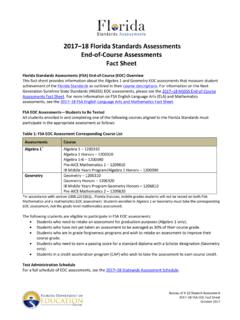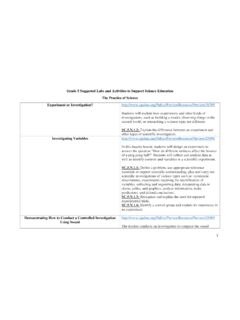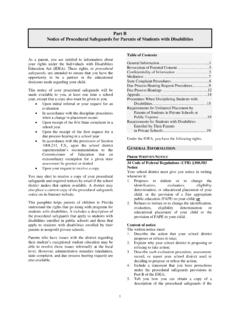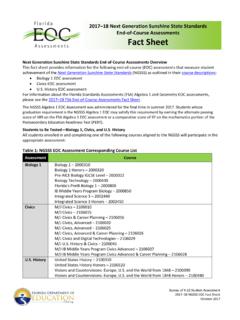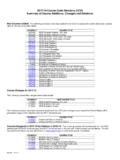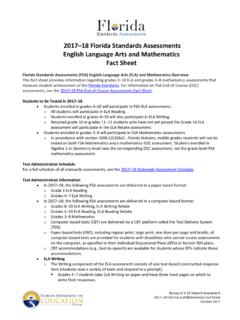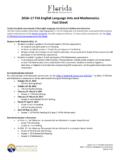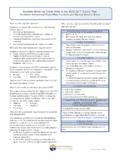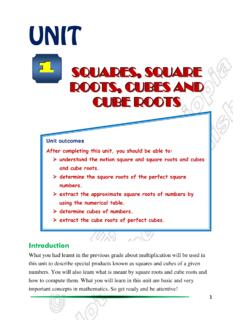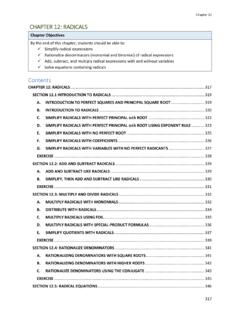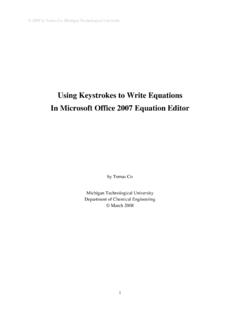Transcription of Mathematics Florida Standards (MAFS) Grade 8
1 | #FLStandards 2014, Florida Department of Education. All Rights Reserved. Mathematics Florida Standards (MAFS) Grade 8 Domain: THE NUMBER SYSTEM Cluster 1: Know that there are numbers that are not rational, and approximate them by rational numbers. (Supporting Cluster) Don t sort clusters from Major to Supporting, and then teach them in that order. To do so would strip the coherence of the mathematical ideas and miss the opportunity to enhance the major work of the Grade with the supporting clusters. STANDARD CODE STANDARD Know that numbers that are not rational are called irrational. Understand informally that every number has a decimal expansion; for rational numbers show that the decimal expansion repeats eventually, and convert a decimal expansion which repeats eventually into a rational number.
2 Cognitive Complexity: Level 1: Recall Use rational approximations of irrational numbers to compare the size of irrational numbers, locate them approximately on a number line diagram, and estimate the value of expressions ( , ). For example, by truncating the decimal expansion of 2, show that 2 is between 1 and 2, then between and , and explain how to continue on to get better approximations. Cognitive Complexity: Level 2: Basic Application of Skills & Concepts Domain: EXPRESSIONS & EQUATIONS Cluster 1: Work with radicals and integer exponents. (Major Cluster) Don t sort clusters from Major to Supporting, and then teach them in that order.
3 To do so would strip the coherence of the mathematical ideas and miss the opportunity to enhance the major work of the Grade with the supporting clusters. STANDARD CODE STANDARD Know and apply the properties of integer exponents to generate equivalent numerical expressions. For example, 3 ==1/3 =1/27 Cognitive Complexity: Level 1: Recall Use square root and cube root symbols to represent solutions to equations of the form x = p and x = p, where p is a positive rational number. Evaluate square roots of small perfect squares and cube roots of small perfect cubes. Know that 2 is irrational. Cognitive Complexity: Level 1: Recall Use numbers expressed in the form of a single digit times an integer power of 10 to estimate very large or very small quantities, and to express how many | #FLStandards 2014, Florida Department of Education.
4 All Rights Reserved. times as much one is than the other. For example, estimate the population of the United States as 3 and the population of the world as 7 , and determine that the world population is more than 20 times larger. Cognitive Complexity: Level 1: Recall Perform operations with numbers expressed in scientific notation, including problems where both decimal and scientific notation are used. Use scientific notation and choose units of appropriate size for measurements of very large or very small quantities ( , use millimeters per year for seafloor spreading). Interpret scientific notation that has been generated by technology.
5 Cognitive Complexity: Level 2: Basic Application of Skills & Concepts Cluster 2: Understand the connections between proportional relationships, lines, and linear equations. (Major Cluster) Don t sort clusters from Major to Supporting, and then teach them in that order. To do so would strip the coherence of the mathematical ideas and miss the opportunity to enhance the major work of the Grade with the supporting clusters. STANDARD CODE STANDARD Graph proportional relationships, interpreting the unit rate as the slope of the graph. Compare two different proportional relationships represented in different ways. For example, compare a distance-time graph to a distance-time equation to determine which of two moving objects has greater speed.
6 Cognitive Complexity: Level 2: Basic Application of Skills & Concepts Use similar triangles to explain why the slope m is the same between any two distinct points on a non-vertical line in the coordinate plane; derive the equation y = mx for a line through the origin and the equation y = mx + b for a line intercepting the vertical axis at b. Cognitive Complexity: Level 2: Basic Application of Skills & Concepts Cluster 3: Analyze and solve linear equations and pairs of simultaneous linear equations. (Major Cluster) Don t sort clusters from Major to Supporting, and then teach them in that order. To do so would strip the coherence of the mathematical ideas and miss the opportunity to enhance the major work of the Grade with the supporting clusters.
7 STANDARD CODE STANDARD Solve linear equations in one variable. a. Give examples of linear equations in one variable with one solution, infinitely many solutions, or no solutions. Show which of these possibilities is the case by successively transforming the given equation into simpler forms, until an equivalent equation of the form x = a, a = a, or a = b results (where a and b are different numbers). b. Solve linear equations with rational number coefficients, including equations whose solutions require expanding expressions using the | #FLStandards 2014, Florida Department of Education. All Rights Reserved. distributive property and collecting like terms.
8 Cognitive Complexity: Level 2: Basic Application of Skills & Concepts Analyze and solve pairs of simultaneous linear equations. a. Understand that solutions to a system of two linear equations in two variables correspond to points of intersection of their graphs, because points of intersection satisfy both equations simultaneously. b. Solve systems of two linear equations in two variables algebraically, and estimate solutions by graphing the equations. Solve simple cases by inspection. For example, 3x + 2y = 5 and 3x + 2y = 6 have no solution because 3x + 2y cannot simultaneously be 5 and 6. c. Solve real-world and mathematical problems leading to two linear equations in two variables.
9 For example, given coordinates for two pairs of points, determine whether the line through the first pair of points intersects the line through the second pair. Cognitive Complexity: Level 2: Basic Application of Skills & Concepts Domain: FUNCTIONS Cluster 1: Define, evaluate, and compare functions. (Major Cluster) Don t sort clusters from Major to Supporting, and then teach them in that order. To do so would strip the coherence of the mathematical ideas and miss the opportunity to enhance the major work of the Grade with the supporting clusters. STANDARD CODE STANDARD Understand that a function is a rule that assigns to each input exactly one output.
10 The graph of a function is the set of ordered pairs consisting of an input and the corresponding output. Cognitive Complexity: Level 2: Basic Application of Skills & Concepts Compare properties of two functions each represented in a different way (algebraically, graphically, numerically in tables, or by verbal descriptions). For example, given a linear function represented by a table of values and a linear function represented by an algebraic expression, determine which function has the greater rate of change. Cognitive Complexity: Level 2: Basic Application of Skills & Concepts Interpret the equation y = mx + b as defining a linear function, whose graph is a straight line; give examples of functions that are not linear.
